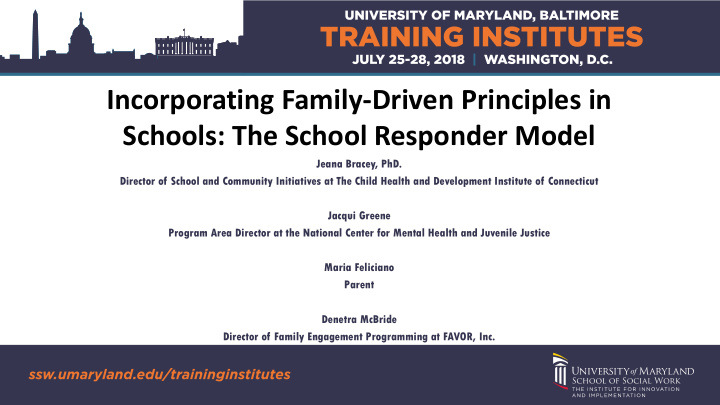



Incorporating Family-Driven Principles in Schools: The School Responder Model Jeana Bracey, PhD. Director of School and Community Initiatives at The Child Health and Development Institute of Connecticut Jacqui Greene Program Area Director at the National Center for Mental Health and Juvenile Justice Maria Feliciano Parent Denetra McBride Director of Family Engagement Programming at FAVOR, Inc.
Origins of the School Responder Model (SRM) rk 2007 2007-2011 2011 Ment ntal al Health/J th/Juveni enile le Justi tice ce Acti tion on Netwo twork Participants: CT, CO, Ill, LA, OH, PA, TX, WA Major issues: – Keep kids out of the system as much as possible – Train adults – Focus on family engagement Models ls for Cha hange nge – MacArthur thur Found ndat ation ion Coordinated by the National Center for Mental Health and Juvenile Justice
Intersection of Behavioral Health and School-Justice Pathways
Justice System Contact and Graduation Students who are Students who are arrested are twice as processed in court are likely not to graduate four times as likely not as those who are not to graduate as those arrested who are not processed through court
Intersection of Behavioral Health and School-Justice Pathways
SRM as an Alternative to the School-Justice Pathway
Where have SRMs worked before? NEVADA 15% CON ONNE NECTICU ICUT reduction in referrals to probation in the first year of utilization court referrals fall by an 45% average of at participating schools, concurrent with decreased arrests, re-arrests, suspensions, and expulsions OH OHIO IO 40% for youths referred for behavior or truancy issues, decrease in likelihood of additional infraction after participation in SRM program
Diversion v. Superintendent's Hearings Weeks 1-30 300 Total Incidents 35.5% Total: 245 SUP Hearing 71.5% 250 Diversion 0.8% Number of Students 200 123 Total: 158 150 35 100 122 123 50 0 2016-2017 2017-2018 Diversion SUP Hearing
What Are Some of the Challenges of Family Engagement? School • Inability to open effective lines of discipline communication with families problems • Struggles to obtain consent for service Extremely provision for students difficult conversations • Lack of family voice in system planning and quality assurance Behavioral health needs
Full Podcast Series: Family and Youth Engagement to Keep Kids in School • Episode 1: Engaging Students to Provide Behavioral Health Supports in Schools • Episode 2: Authentic Family Engagement: It’s More than a Pizza • Episode 3: Helping Students Thrive by Supporting Their Parents and Caregivers https://soundcloud.com/user-500128145
• Who do you need around your SRM planning table?
Barriers to Family Engagement Use your mobile device to participate in the poll. Rank order the listed barriers to family engagement from highest to lowest.
Structural Barriers to Family Engagement • Cultural and linguistic factors • Limited Resources Role of parents in school setting Time o o Language accessibility Incentives o o o Racial/Ethnic identity o Personnel Traditional expectations for involvement Language accessibility o o Mental health stigma and lack of trust Transportation o o Meeting space o Technology o
Structural Barriers to Family Engagement • Traditional Methods of Engagement One-directional communication o Participant/volunteer v. Decision-maker roles o • Power Imbalances Staff v. families o Cultural hierarchy o Access in school building o
Attitudinal Barriers to Family Engagement • Perception of families as disinterested • Limited opportunities to build relationships • Parents’ sense of belonging/comfort in school setting • School climate and culture
FAVOR, Inc. FAVOR, Inc. is a non-profit statewide family organization serving families, children and youth dealing with a broad spectrum of behavioral and mental health needs by providing family peer support and policy initiatives. The organization was established in 2001 and became fully incorporated as a private non profit organization in October 2002.
FAVOR’s Role in The School Based Diversion Initiative (SBDI) Family Engagement Technical Assistance Process • School staff presentations • Family focus groups/community conversations • Brief report with recommendations to remedy gaps in family engagement .
What word pops out at you when you think of Sch choo ool l & F Fam amily ily Engagement gement ?
Definition of Family Engagement Famil ily y engag gagement ement in schoo hools ls is the participation of parents in regular, two-way and meaningful communication involving students’ academic learning and other school activities. Family ily engag gageme ement nt in behavioral havioral health alth is the process by which families and providers develop and maintain a connection while simultaneously demonstrating and communicating information, needs, attitudes, and values. This definition suggests that engagement is an ongoing process necessary to develop and keep a positive alliance.
A Family Story … What experiences did the family struggle with? What resources would this family have liked the school to have offered to her and her family? And when? What was the school’s solution? How can your school create support services for families and youth?
• Identify and maintain a key staff member who will be the champion for supporting family engagement activities • Establish Utilize the family organization in training of families, youth and staff. • Maintain regular communication between families and school staff to understand what engagement strategies benefit each families. • Identify, develop and support Parent Advisory Councils and Parent Teacher Student Organizations.
• Creating a safe space to openly discuss concerns and working together to collaborate • Mental health needs and barriers at school
• True family engagement happens when there is trust between school providers, parents, and students • Parent involvement in the planning of their child’s Individualized Educations Plan (IEP) • Consistency in providing tangible supports/resources, opportunities and inclusion • Power dynamics amongst providers, youth, and families • Cultural diversity and responsiveness when interacting with students and families
Thank you! Jacqui Greene jgreene@prainc.com Jeana Bracey bracey@uchc.edu Denetra McBride dmcbride@favor-ct.org Maria Feliciano maria.feliciano@yahoo.com
Recommend
More recommend